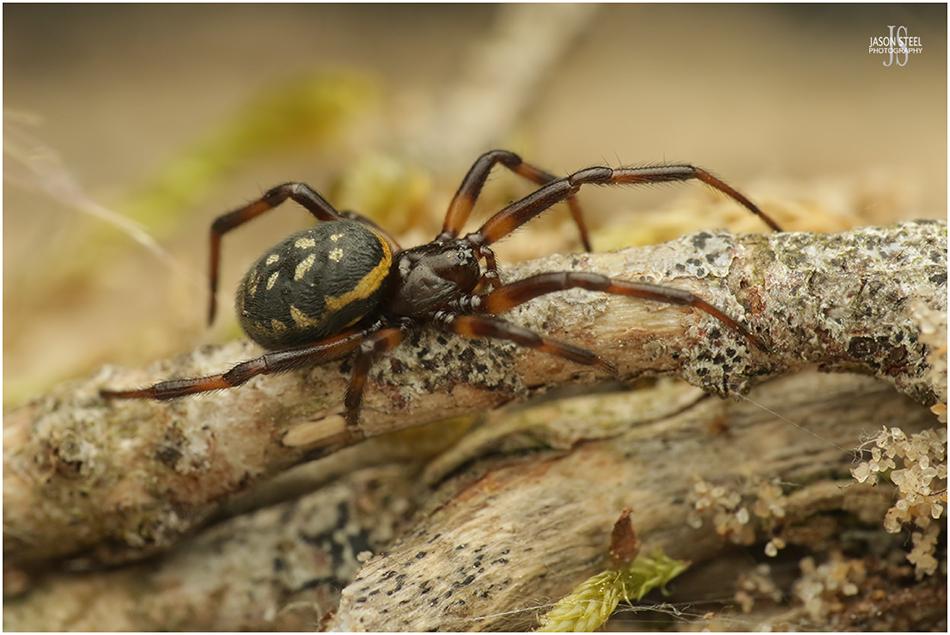
5mm female Steatoda albomaculata, photographed at Holkham, north Norfolk, in June 2024
White-Spotted False Widow - (Steatoda albomaculata)
Steatoda albomaculata is a native, and nationally rare, small species of False Widow spider. Steatoda albomaculata is largely a heathland species and is mainly confined to central-southern England and East Anglia. It also has a widespread and scattered distribution on some heathland sites in Dorset, the New Forest, Surrey and Breckland. The Norfolk coast seems to be an area where this species has a stronghold on coastal sand-dunes at several coastal sites. - LINK. Other less frequently used common names for Steatoda albomaculata include: the White-marked Cobweb Weaver, and the Punctate False Widow, a name more commonly used in the USA. As well as being native to the UK Steatoda albomaculata is also found in North America, Europe, Russia, North Africa, Israel, Kazakhstan, Iran, Central Asia, China, Korea, Japan and more recently India.
The White-Spotted False Widow's typical habitat is dry, sandy, heathland, shingle or under stones on sandy soil, with scarce vegetation. This species gets its name from the two parallel rows of oval-shaped, pale spots on the abdomen. The first half of the Spider's name, Steatoda, lets us know the spider belongs to the Steatoda genus, which consists of the False Widow spiders. The second half of the spider's name, Albomaculata, identifies the spider to the specific species. Albomaculata or albomaculatus, is composed of two Latin words: albus, meaning white, and maculatus, which means spotted. The pairs of white spots, that usually run in two rows, can sometimes be merged together. It's fairly common for one or two pairs of these spots to be merged, especially with immature specimens, but occasionally all the pairs of spots can be merged together, creating a single row of markings that almost look triangular. These specimens could be mistaken for Steatoda triangulosa, in countries such as the USA, where both species are present. The ventral markings would still easily distinguish the two species though. One such specimen can be viewed here. Steatoda albomaculata is sometimes known as the Seven-spotted False Widow, rather than more widely used common name, the White-Spotted False Widow.
As with other Steatoda species the White-Spotted False Widow also has a pale band at the front of the abdomen, which on this species turns into a series of triangles as it runs along the flanks of the abdomen. The abdominal markings can be white, grey, cream or yellow in colour. Occasionally the markings can have a pinkish hue.
The legs are strongly banded with wide orange and black / dark brown annulations. Adult females usually grow to around 3-6mm in body-length and males typically reach around 4-5mm. Some female specimens may reach 7mm in length. Although Steatoda albomaculata can be found all year round adults are usually found from April to October, with two peaks from May to June, and from August to September. Mature males are very similar in appearance to the females but have a more slender abdomen, a flatter, wider carapace, and quite obvious, dark palpal bulbs.
Like other Steatoda species Steatoda albomaculata builds itself a messy tangle-web to catch its prey. The web of Steatoda albomaculata isn't like that of other Steatoda species in the UK though. This web is small, very loose, consists of a minimal number of silken threads, and looks like an old abandoned web, in a bad state of dis-repair. The webs are usually constructed at ground level, either at the base of heathland vegetation, under rocks, across small depressions in the bare, rocky or sandy ground, between rocks, or under overhanging vegetation on sand-dunes. Webs are sometimes built amongst leaf litter and detritus. Where webs are built across small depressions in the bare ground the spider often hides in its retreat beneath the web, in a small hole in the ground. Specimens have been found with webs built on cliff edges too. This makes finding the White-spotted False Widow that much harder than other Steatoda species. - LINK LINK 2
This species is often found in areas that support large numbers of ants, upon which this spider readily preys. They have also been observed wrapping beetles and small bees at ground level in silky threads. This species has declined significantly in recent years. This could be partly due to habitat loss. The White-Spotted False Widow is dependant on bare, sandy soil and the improved control of heathland fires in recent years could actually be detrimental to the long-term survival of this spider. This loss of habitat is not just confined to the UK though. Other countries, including Germany, now consider Steatoda albomaculata to be endangered.
The abdominal markings of sub-adult Pachygnatha degeeri can sometimes be mistaken for Steatoda albomaculata, allowing for confusion between the two species. - LINK
My Quest For Steatoda albomaculata
My quest to photograph the rarest species of False Widow in the UK led me to scan through many social media posts from the last few years, and google many sites where this illusive species had previously been found. Most records around Surrey heathland, which were closest to my SE London home, seemed to only be isolated specimens and the chances of finding one at these sites would be very slim. After all this is a rare species that builds a small discreet web at ground level. The only records I could find that included several specimens from the same site all seemed to come from the Norfolk area. So on my week off work in June 2024 I decided to head off to the coastal site of Holkham, in north Norfolk, for a few days. It took some convincing to get my wife onboard with the idea, and sell her on the premise that Holkham was situated in a very beautiful part of the country, which it most definitely is.
Warning signs were announcing the closure of many sites in the Holkham area for filming purposes over the next few days so the pressure was on to find this spider in a short space of time. North Norfolk is a long drive up from SE London and this wasn't an opportunity I would be likely to have again any time soon..
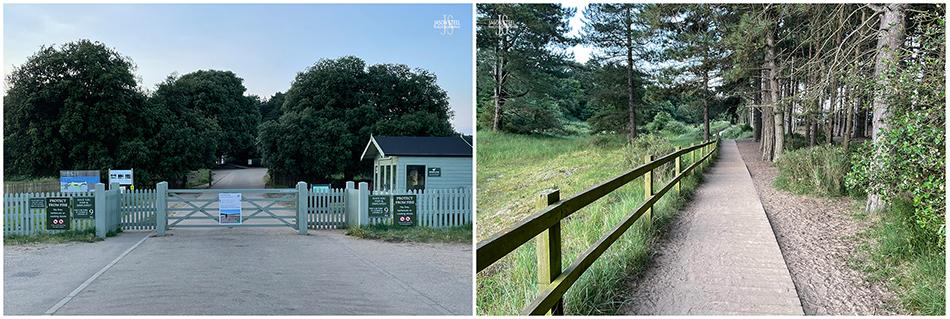
On our first morning in Holkham we headed down to the Holkham Nature Reserve. The site is free to enter, large and easy to find. There is ample parking, but it comes at a price, £13.50 for the day in June 2024. Whilst we walking to the entrance it was immediately obvious that this site was hugely popular with both bird-watchers and dog walkers alike. Once through the gates there is a wooden boardwalk that takes you along a five minute stroll through a wooded strip that leads out onto a vast open beach.
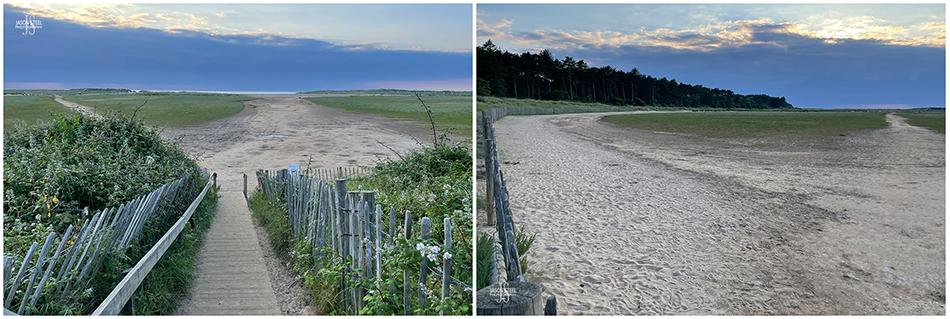
Once onto the beach we turned left and headed westward with the woods on our left and the sea on our right. At the coastal edge of the beach there are large sand dunes, covered in marram grass. In between the sea and the woods there is an expanse of flat, open sand, followed by sandy soil and sparse vegetation, and then the old grey dunes which run along the woodland edge. These old grey dunes are much lower in height than the dunes nearer the sea. They have a more diverse variety of sparse, low vegetation, and here the marram grass doesn't grow.
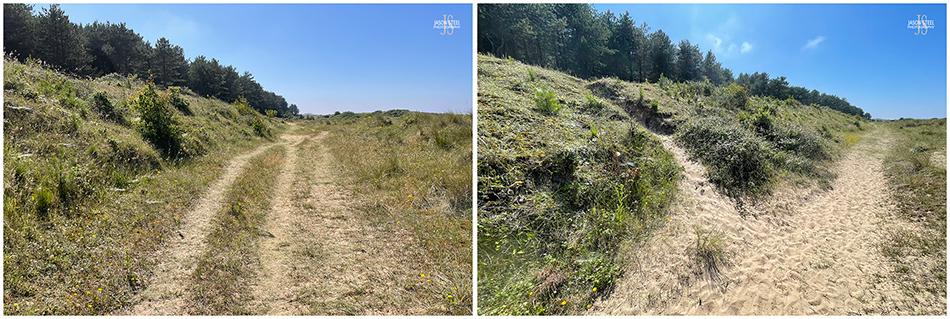
Having read that Steatoda albomaculata is usually found in dry, Sandy, stony soil, where very sparse vegetation can be found, I proceeded to walk westwards tin search of ideal habitat. Along my travels I began to check out all the terrain along the route. The tall sand dunes nearest the coast weren't suitable at all. There were no stones, or any other objects at ground level, where the spiders could hide under. The sand was light and fluffy, and was clearly incapable of supporting much vegetation, besides the abundance of marram grass that grew there. The old grey dunes looked far more promising and I was quickly able to spot webs in every space amongst the low vegetation. My initial excitement soon turned to frustration when I inspected the webs though. These were not the webs of Steatoda but the webs of the Labyrinth Spider, Agelena labyrinthica. It then became very obvious that Agelena labyrinthica was the dominant arachnid species in the area. These Labyrinth Spiders were so numerous that I couldn't see how Steatoda albomaculata could possibly be found here. I continued my walk and paid close attention to the number of Labyrinth Spider webs distributed along the route. I had probably walked about half a mile along Holkham Beach before the Labyrinth Spiders seemed to have a slightly more scattered distribution and the webs weren't quite so numerous. At this stage I decided to start my search once again for the White-Spotted False Widow. The soil still consisted of fairly lose sand, and there was still an obvious lack of stones, or depressions in the ground, where I expected the White-Spotted False Widow to build its web. By this point I started to have my doubts about whether I was going to find my target species at this site or whether I should continue my walk until I reached Burnham Overy, where the habitat looked more suitable, and where more previous sightings had been recorded.

I had read that the horizontal webs of Steatoda albomaculata are often built amongst leaf litter and detritus, in small depressions on bare sandy soil. But such habitat didn't seem to exist at Holkham Beach. It had taken me several hours of searching before I chose to ignore what I had read from others and I started checking out the shaded areas beneath the overhanging grass tussocks on the grey dunes. Searching in these spots didn't take me too long before I discovered a vertical web that looked like it could have been built by a small Steatoda species. The web was around 18cm by 15cm. It was thin and in an apparent poor state of disrepair. It looked like whatever had once lived there was now long gone. Being the first semi-appropriate web that I had encountered I decided to try my luck anyway and look for a spider in the vicinity. After 30 seconds of gentle tapping at the edge of the web, with a very fine blade of grass, I noticed a pair of front legs appear from under the tussock. I continued to tap the web in the hope of enticing the spider out further. Much to my disappointment though this only succeeded in driving the spider back into its hideaway at the top of the web, where it was now out of sight under the overhanging low vegetation. Now that I knew that the web was indeed still inhabited, and I knew approximately where the spider was hiding, I chose to take a more proactive approach. I placed my large pot under the web and vigorously tapped the top of the overhanging vegetation.
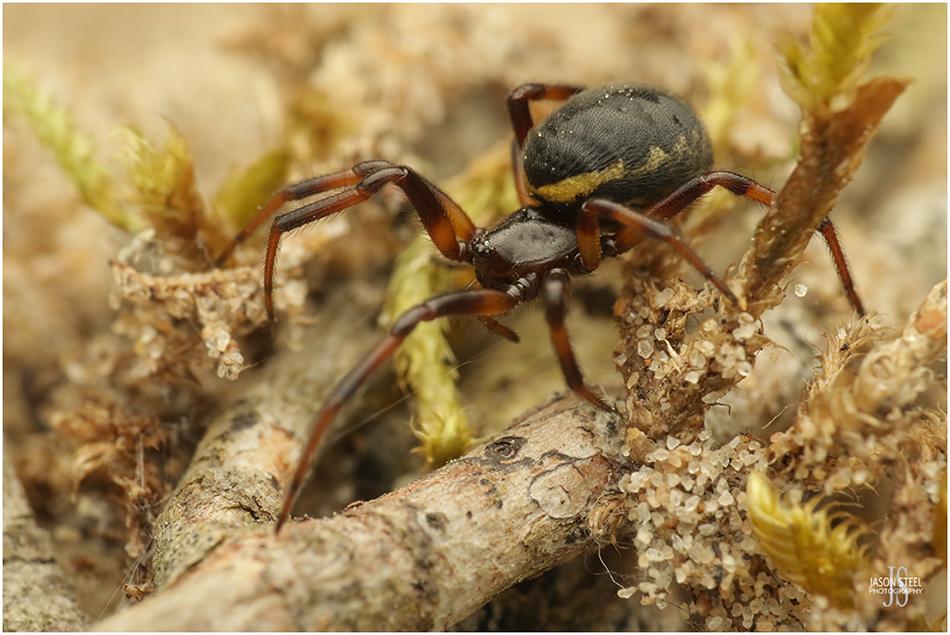
6mm female Steatoda albomaculata, photographed at Holkham, north Norfolk, in June 2024
My pot began to collect lose soil, twigs and other debris that fell from the overhang, and then finally a spider. With a body-length of 6mm this spider looked the right size and the right shape for Steatoda albomaculata. But something wasn't right, this spider lacked any abdominal markings. Where were the two rows of pale spots on the abdomen that gave the White-Spotted False Widow its name? My eyesight isn't what it used to be and I decided the only way to identify this spider with any certainty would be to take a photo and zoom in on the image. I placed the spider into a very small clear pot and tipped it upside down on the sandy ground surface. The pot was made of transparent plastic and I left it in place until I could see the spider had stopped running around and had momentarily settled. I then carefully lifted off the pot and was pleasantly surprised that the spider continued to remain motionless in the same spot. I quickly got myself into position and took the first few shots with my camera. I then slowly placed the pot back over the top of the spider and inspected my images. And then the moment of realisation came. This was indeed a White-Spotted False Widow, Steatoda albomaculata! It was an older female specimen. The white spots had faded across most of its abdomen but were still faintly visible at the rear. The abdominal band was bright yellow and it blended into faded triangular markings along the spider's flanks. I was now filled with a huge sense of relief and satisfaction. My long journey had been a success and this nationally rare species could now be photographed and finally added to my website to complete the Steatoda genus.
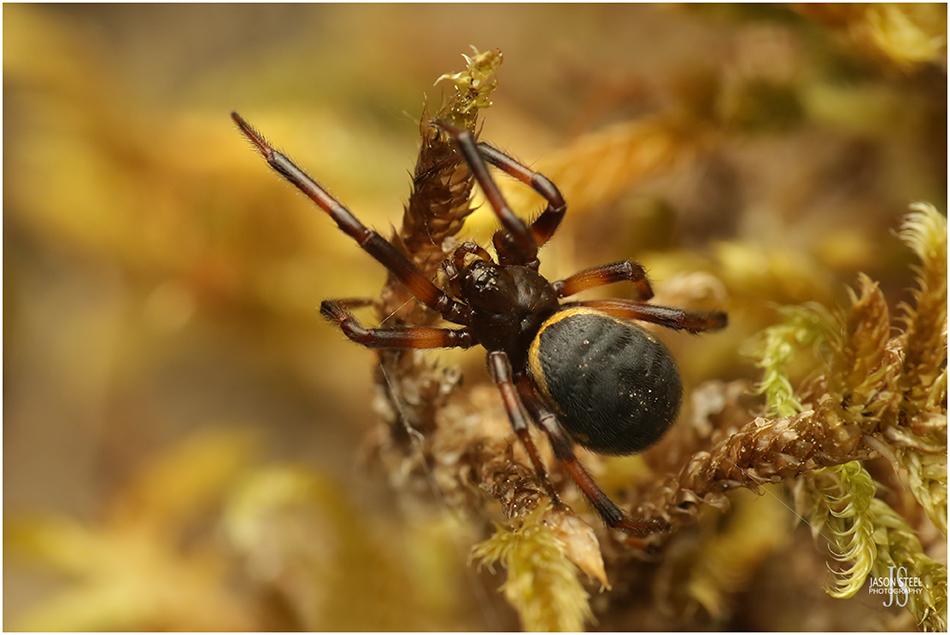
6mm female Steatoda albomaculata, photographed at Holkham, north Norfolk, in June 2024
I continued to take a few dozen more photos of this female Steatoda albomaculata. I knew that this might well be my only chance to photograph this rare species and I wanted to make sure I took full advantage of the opportunity. Photographing a dark spider against a bright sandy background presents its own challenges. With the majority of my photos I either over-exposed the background or the spider itself was under-exposed. Thankfully I ended up with some fairly well balanced shots that could be corrected at the editing stage. Now that I knew where to look for this species at Holkham I decided to continue my search once again. I now hoped to find either a male specimen, or a specimen that exhibited the white-spotted abdominal markings typically associated with this species.
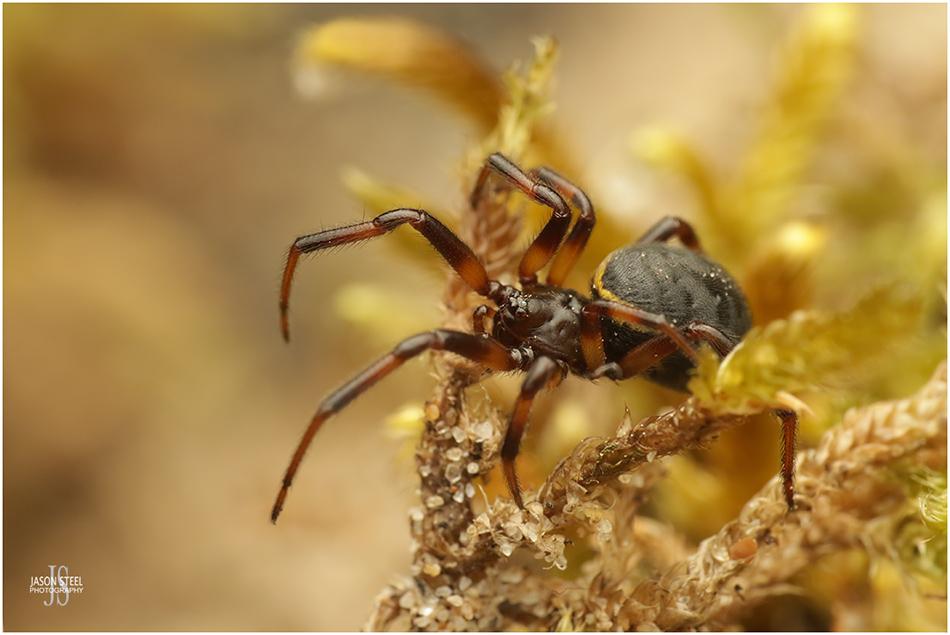
6mm female Steatoda albomaculata, photographed at Holkham, north Norfolk, in June 2024
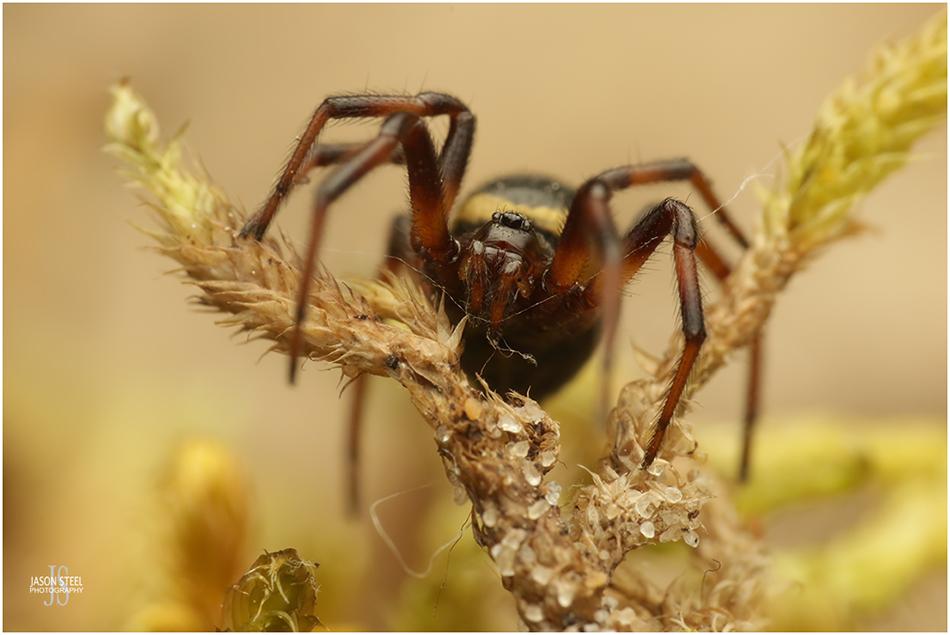
6mm female Steatoda albomaculata, photographed at Holkham, north Norfolk, in June 2024
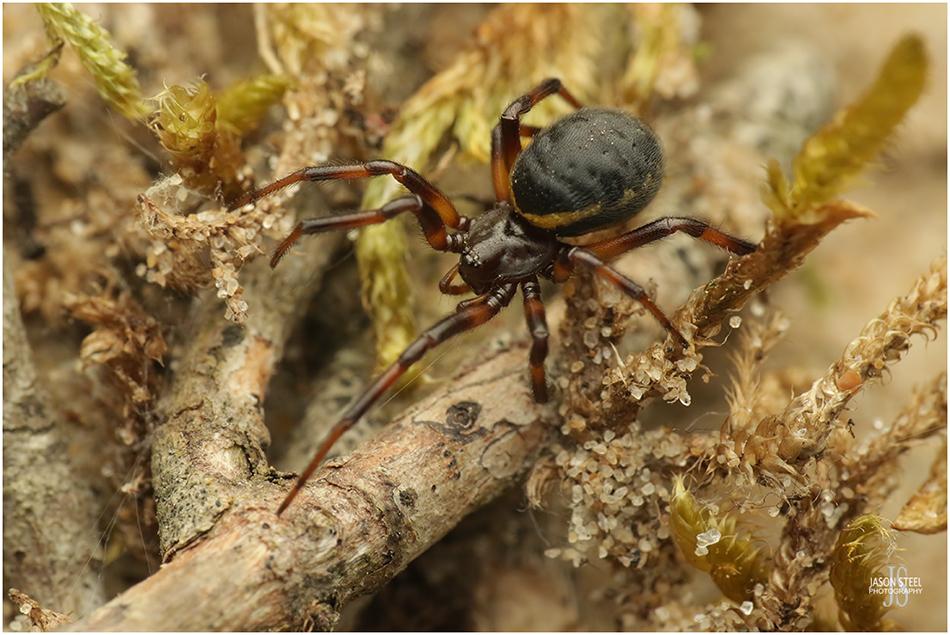
6mm female Steatoda albomaculata, photographed at Holkham, north Norfolk, in June 2024
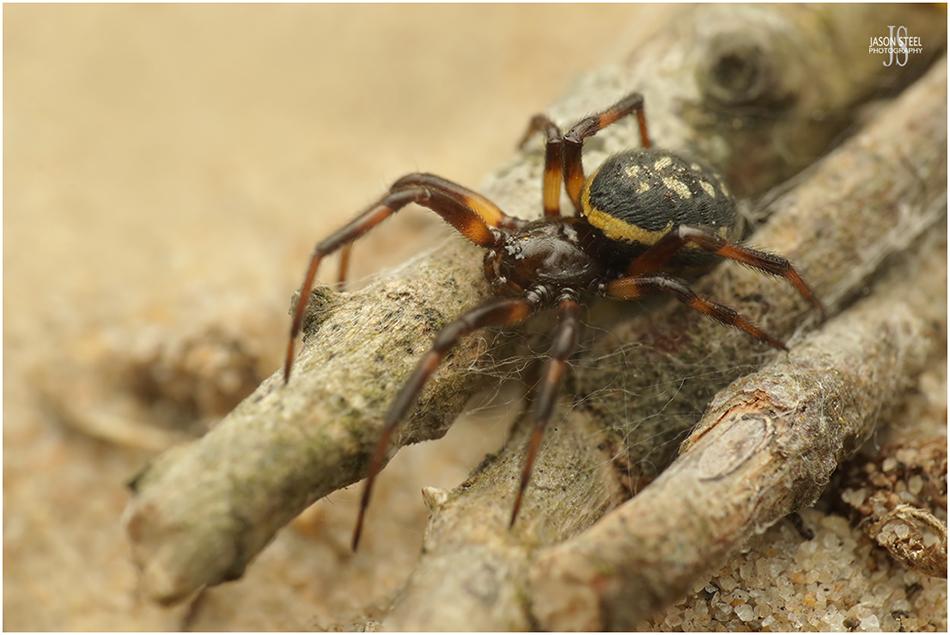
5mm female Steatoda albomaculata, photographed at Holkham, north Norfolk, in June 2024
Despite taking several hours to find my first Steatoda albomaculata at Holkham I was now confident that I was in the right area and that I would be able to find another specimen with a little more ease than the previous one. It didn't take too long before I found a few more suitable looking webs, which were also located beneath the overhanging vegetation in the sandy soil. Unfortunately I failed to find any occupants within these webs despite my thorough searching. I found another web, this time of just 12cm by 10cm in size. This web contained a small beetle of undetermined species, that was wrapped in silk. My previous tapping of the web with a thin blade of grass worked successfully for me once again and it wasn't too long before I could see a pair of legs appearing from beneath the overhanging vegetation that obscured the top of the web. This time I didn't hesitate to press my large pot against the bottom of the overhang and I was quickly able to dislodge the spider from its web and catch it in my pot. Success again! This was another adult female Steatoda albomaculata. A slightly smaller specimen at 5mm in body-length, but with far better abdominal markings. The yellow abdominal band was accompanied by two rows of pale yellow spots that ran along the back of the spider's abdomen. After taking plenty of photos I was able to release both spiders, back into their now somewhat destroyed webs. Hopefully at some point I'll be able to return to this site and search for both male Steatoda albomaculata specimens and juvenile specimens to photograph and add to this page of my website, but for now my adventure in north Norfolk had come to an end.
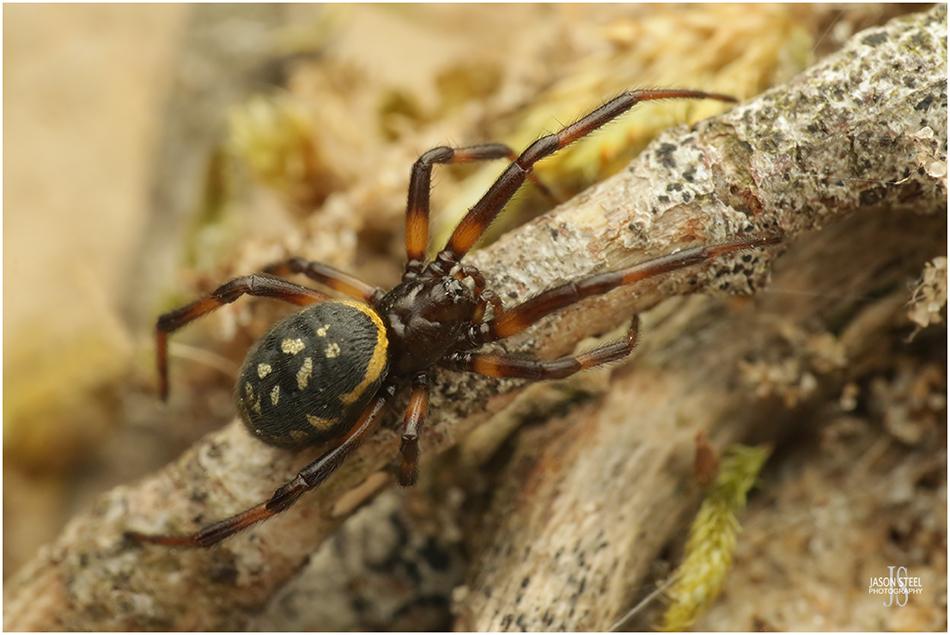
5mm female Steatoda albomaculata, photographed at Holkham, north Norfolk, in June 2024

5mm female Steatoda albomaculata, photographed at Holkham, north Norfolk, in June 2024
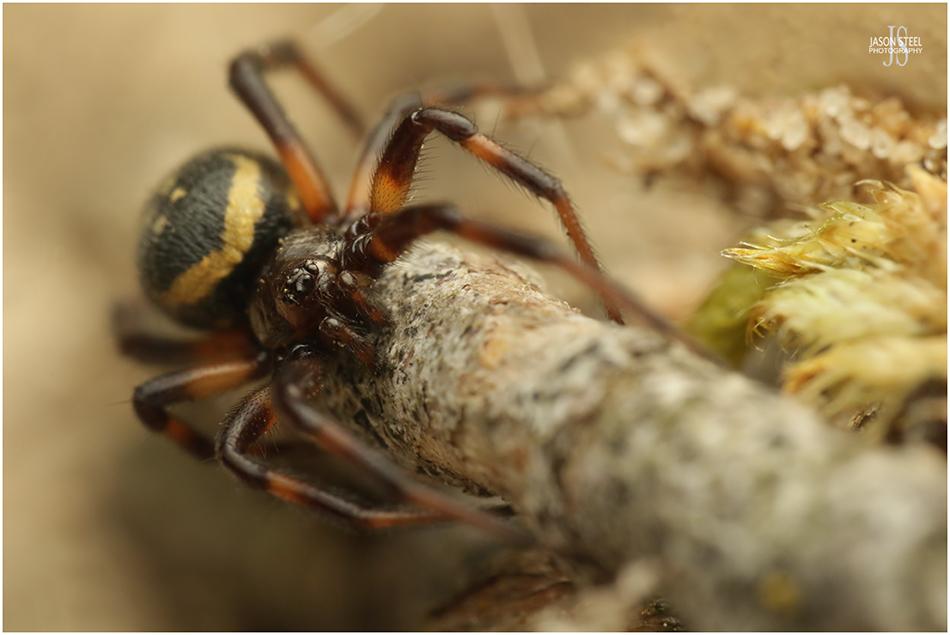
5mm female Steatoda albomaculata, photographed at Holkham, north Norfolk, in June 2024
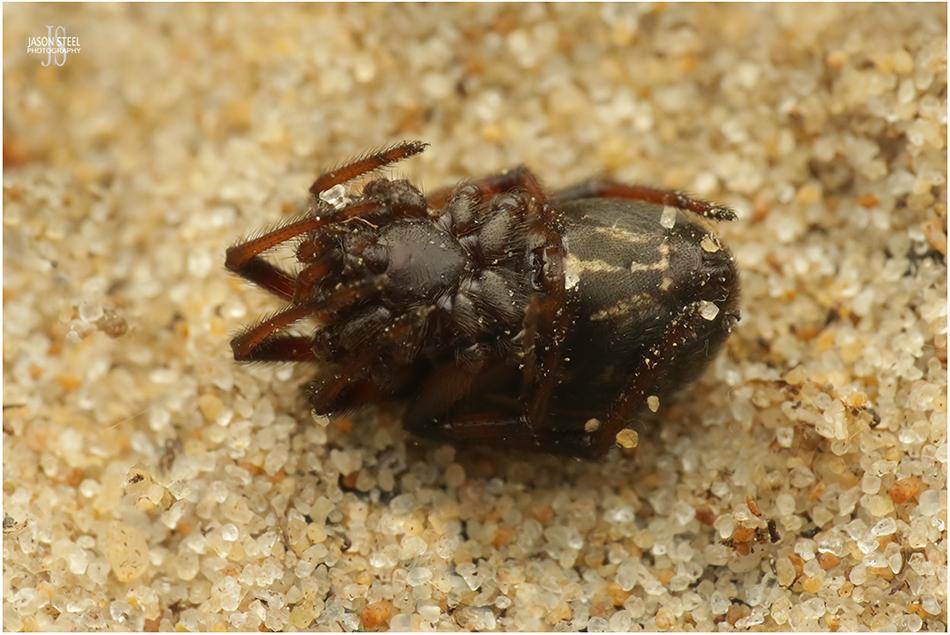
Both Steatoda albomaculata specimens played dead at some point during our photo session, allowing me the opportunity to photograph the ventral markings.
Steatoda albomaculata or Steatoda incomposita?
In southern Europe, Where Steatoda albomaculata is fairly common, there is another Steatoda species that's even rarer, and very difficult to separate from Steatoda albomaculata, and that is Steatoda incomposita. Some sources claim that the two can be distinguished if you have a clear view of the ventral side of the abdomen. Steatoda incomposita is reported to have three white lines on the underside of the abdomen, which usually converge to form an anchor pattern, whereas albomaculata is reported to have just the one white line. - LINK
When looking at the underside of both the specimens I found at Holkham I was surprised to discover that the abdominal markings on the ventral side clearly showed the three pale lines, converging to form an anchor pattern, as described to be found on Steatoda incomposita rather than Steatoda albomaculata.
So what does this mean? Does it mean that the False Widows found on the sand dunes at Holkham Beach are not Steatoda albomaculata, but are actually Steatoda incomposita? No, reading the British Arachnological Society's bulletin from 1996 it clearly shows the ventral markings of Steatoda incomposita as having just one pale line on the underside of the abdomen. This BAS bulletin presents a review of the species in 1996 by the University of Innsbruck, in Austria, where Barbara Knoflach concluded that Steatoda albomaculata and Steatoda incomposita can only be distinguished by their genitalia.
Photos shown on many online sources show both species having three pale lines on the ventral side of their abdomen. So it looks like we can definitely conclude that the ventral markings of both Steatoda albomaculata and Steatoda incomposita can be either one pale line or three pale lines that converge to form an anchor pattern. It appears that the two species cannot be separated using ventral markings and microscopic examination of the reproductive organs of mature specimens is needed. And it seems other experts agree with this too. - LINK.
There is also another very similar species too, Steatoda dahli, which occurs in countries including Turkey, Israel, Caucasus, Russia, Central Asia, and Iran. Steatoda dahli is also extremely difficult to separate from both Steatoda albomaculata and Steatoda incomposita. Care must now be taken when referring to the White-Spotted False Widow as this term could be used to describe any of the three species. - LINK, LINK 2.
Steatoda incomposita review - LINK
Other Steatoda albomaculata records from the UK
Male Steatoda albomaculata have been found out wandering on the sand dunes at Bunham Overy, Norfolk, during the daytime in May, as they search for the webs of female mating partners. - LINK. An adult male specimen was also photographed in April 2018 at Bunham Overy, Norfolk. - LINK.
Seven specimens were easily found at Blakeney Point, a coastal site in north Norfolk, in August 2023. The image shown appears to be that of a sub-adult specimen, which are generally paler in shade. The banding on the legs are not as bold with sub-adults. The two rows of pale spots on the abdomen are larger and more likely to converge, and the pale band at the front of the abdomen runs all the way around the flanks, where it turns into triangular shapes that can join up with the abdominal markings. - LINK
Lackford. Bury St Edmunds.
Suffolk. IP28 6HX
In May 2022 several specimens were photographed in bare sandy and stony soil at this site in West Suffolk. Here the webs were built between or under small stones, or over small depressions in the soil. - LINK. Another specimen was found in June 2022. - LINK. Another specimen was found in August 2022. LINK. Another specimen was found in September 2022. - LINK. Another specimen was found in October 2022. - LINK. Another specimen was photographed at the same site in June 2023. - LINK. Another specimen was found in July 2023. - LINK. Another specimen was found in September 2023. - LINK. Two specimens were also found at this site in February 2024 - LINK
Habitat photos taken at this site can be seen here: Photo 1, Photo 2, Photo 3.
In July 2017 a nicely marked Steatoda albomaculata was found at Holkham Beach. The finder reported finding them regularly around rabbit diggings. Someone else commenting on the post reported finding one in the sand dunes on the nearby Scolt Head Island, an offshore barrier island between Brancaster and Wells-next-the-Sea, in north Norfolk. - LINK
In July 2018 a Steatoda albomaculata specimen was found at RSPB Lakenheath Fen, Brandon, Thetford, Norfolk / Suffolk borders. - LINK
In July 2025 a nicely marked Steatoda albomaculata specimen, that appeared to be a sub-adult female, was found at Hartlebury Common, Worcestershire's largest heathland site. Two small spiderlings were also found. The webs were built on the vertical edges of the sand dunes, at the entrance of a mammal burrow. - LINK
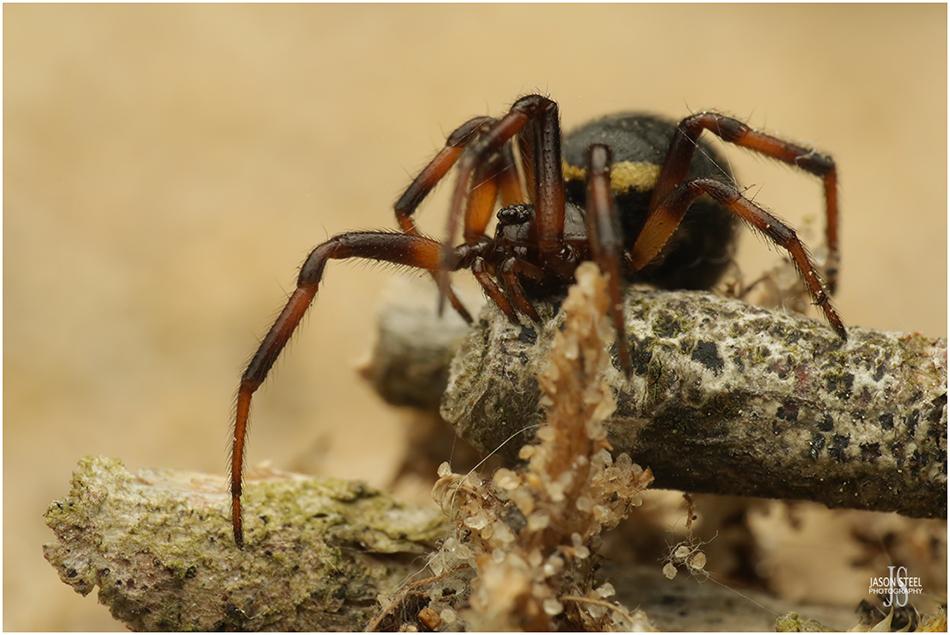
6mm female Steatoda albomaculata, photographed at Holkham, north Norfolk, in June 2024
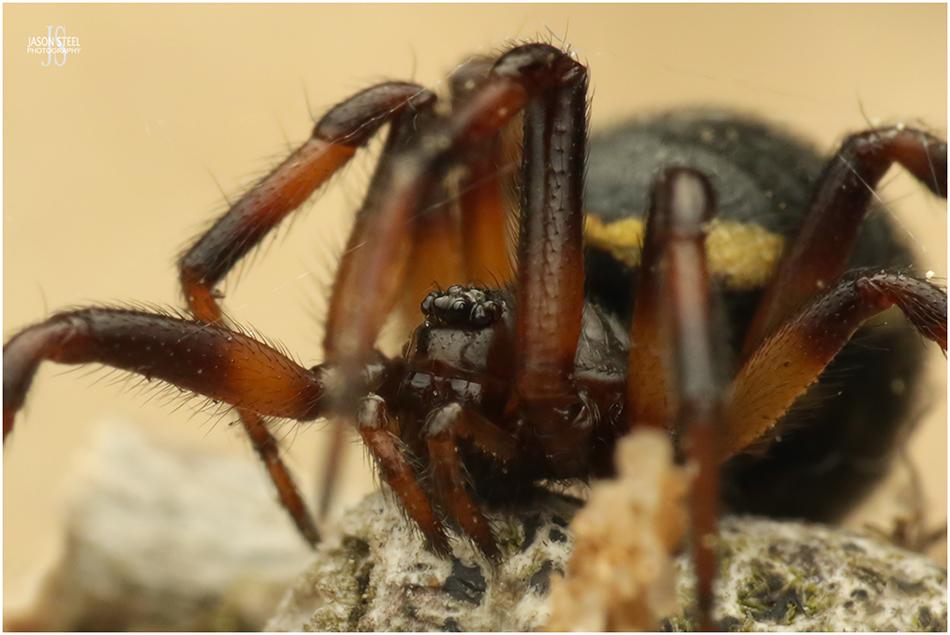
6mm female Steatoda albomaculata, photographed at Holkham, north Norfolk, in June 2024
This image shows the detail in the wonderfully bulbous eye-arrangement of Steatoda albomaculata. As with all other Theridiidae the White-Spotted False Widow has eight eyes.
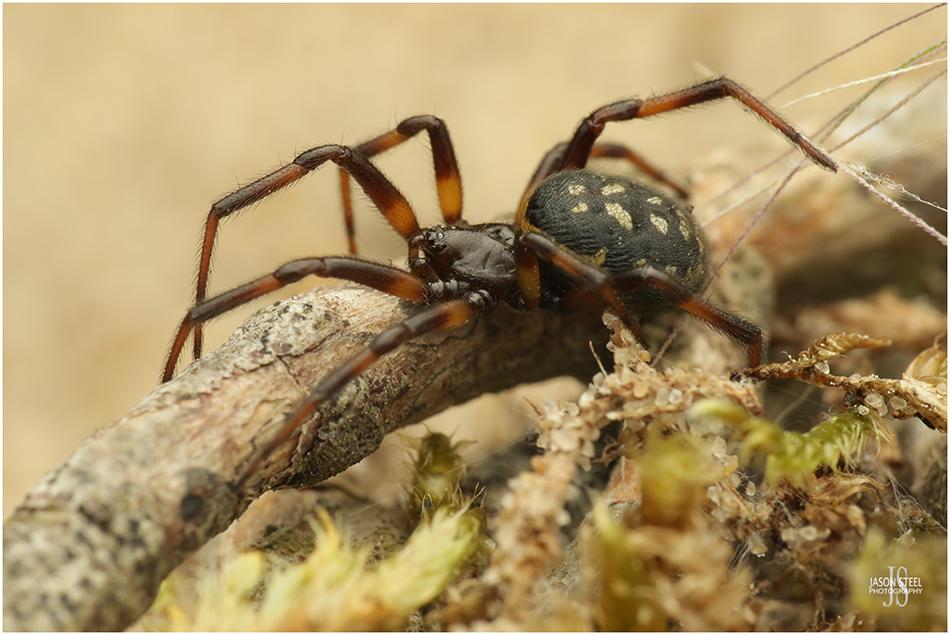
5mm female Steatoda albomaculata, photographed at Holkham, north Norfolk, in June 2024
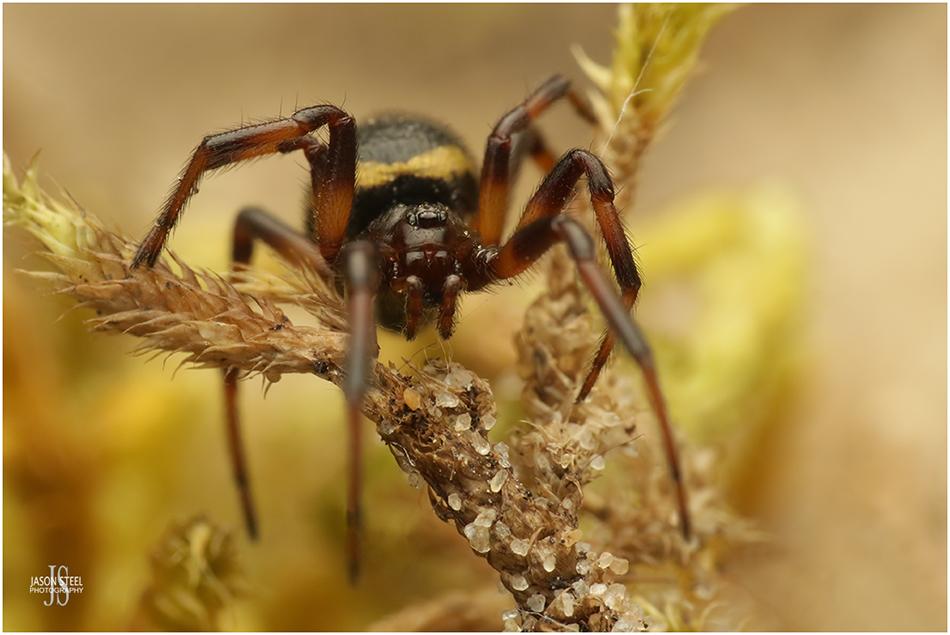
6mm female Steatoda albomaculata, photographed at Holkham, north Norfolk, in June 2024
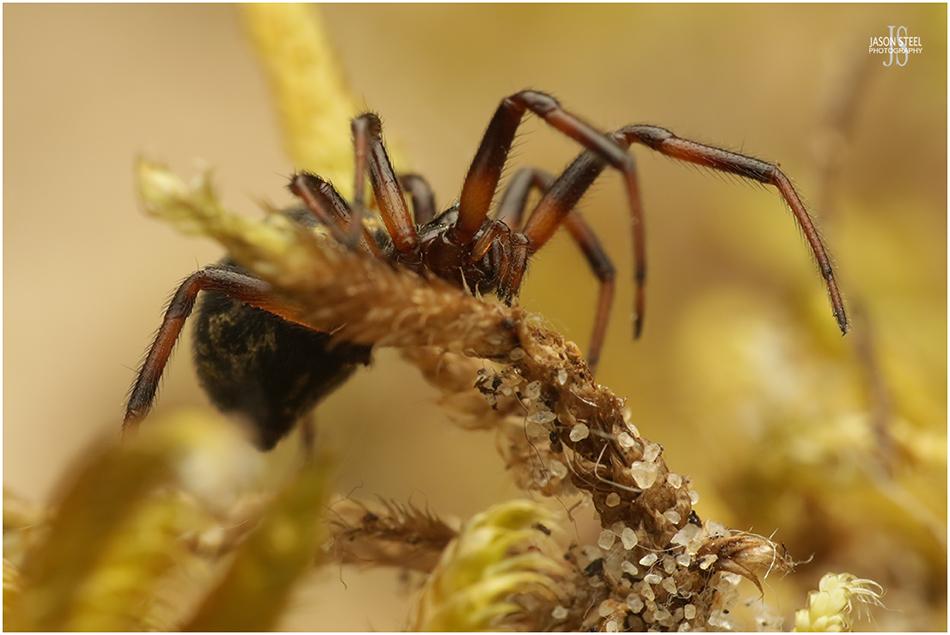
6mm female Steatoda albomaculata, photographed at Holkham, north Norfolk, in June 2024
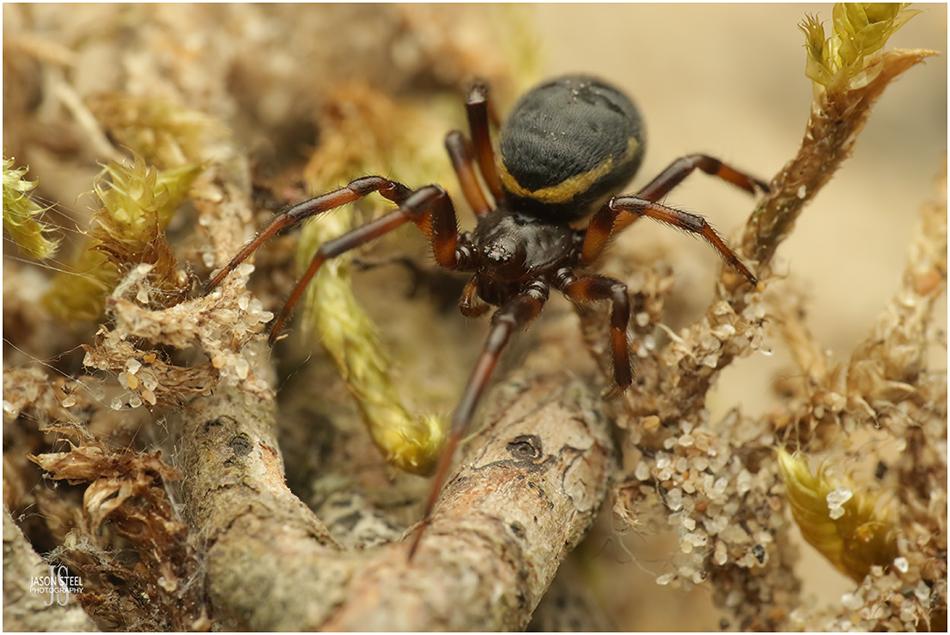
6mm female Steatoda albomaculata, photographed at Holkham, north Norfolk, in June 2024
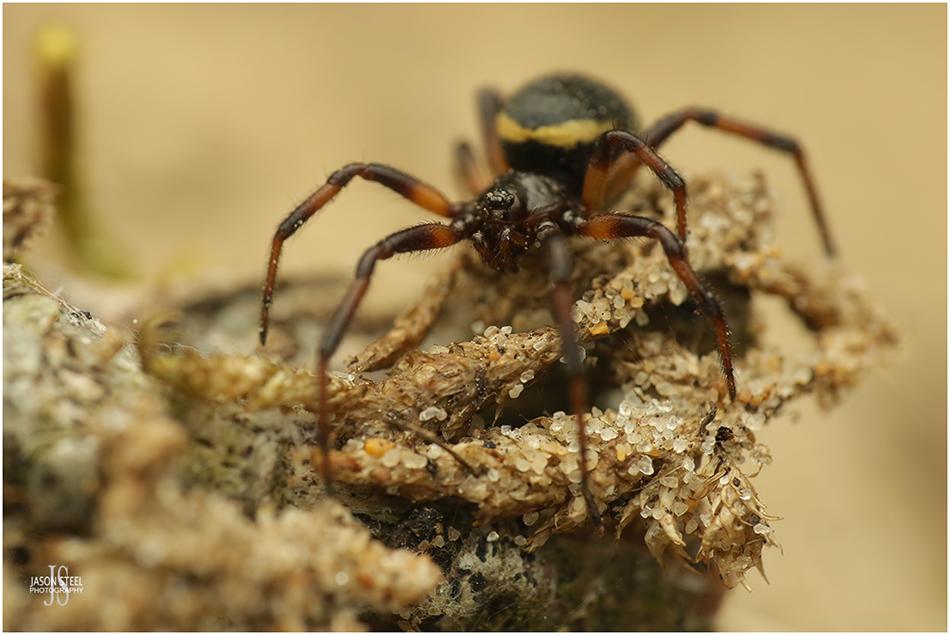
6mm female Steatoda albomaculata, photographed at Holkham, north Norfolk, in June 2024
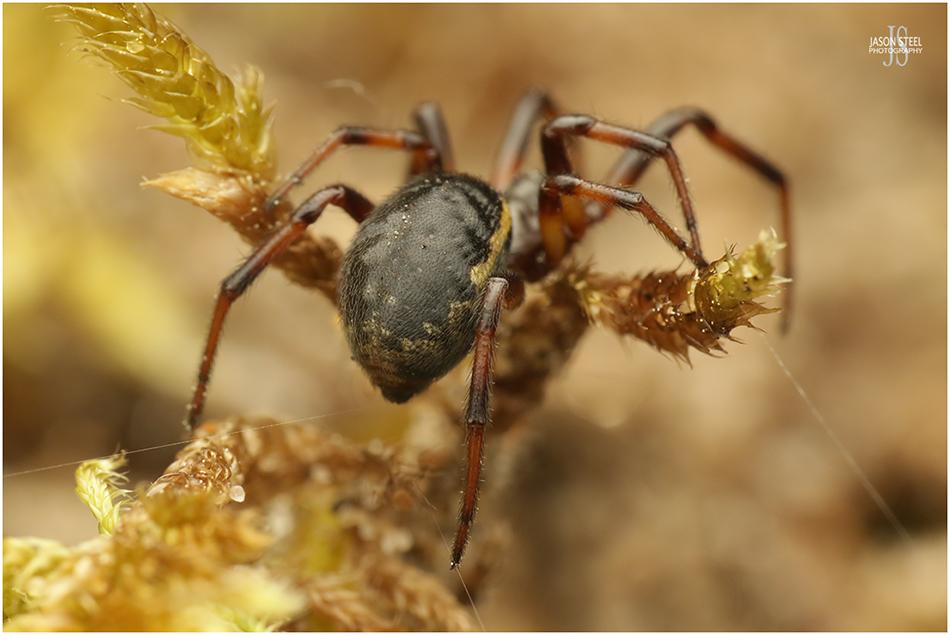
6mm female Steatoda albomaculata, photographed at Holkham, north Norfolk, in June 2024
As seen in this image most of the abdominal markings of this aged female specimen had faded completely. The markings at the rear of the abdomen were feint but still visible. The yellow abdominal band was still bold and clearly visible.
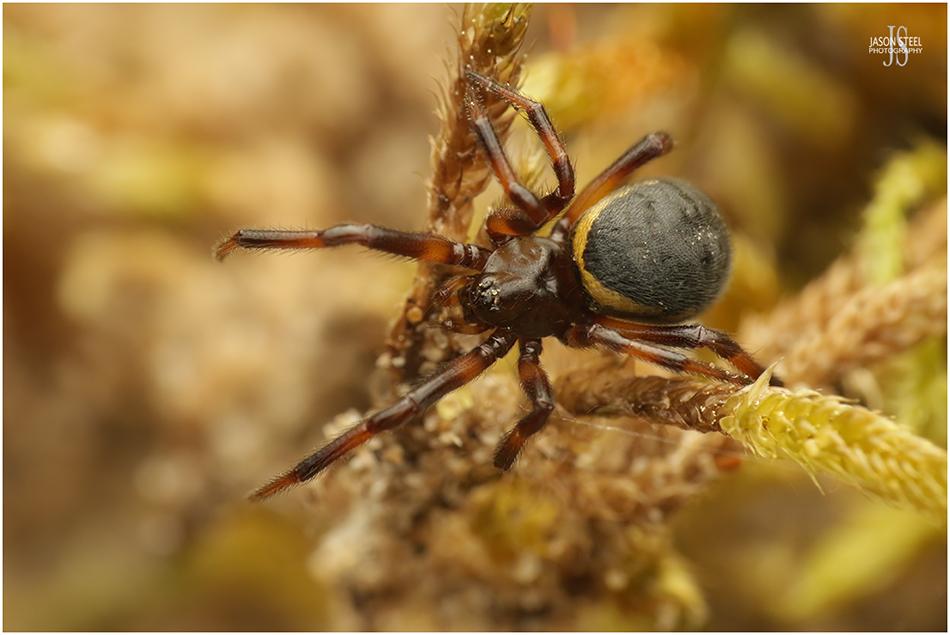
6mm female Steatoda albomaculata, photographed at Holkham, north Norfolk, in June 2024
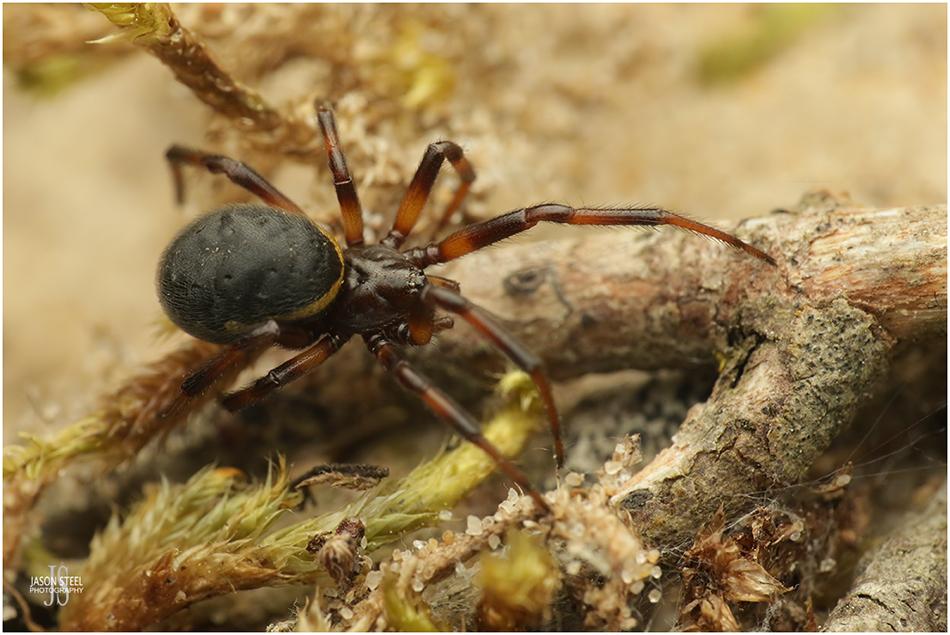
6mm female Steatoda albomaculata, photographed at Holkham, north Norfolk, in June 2024
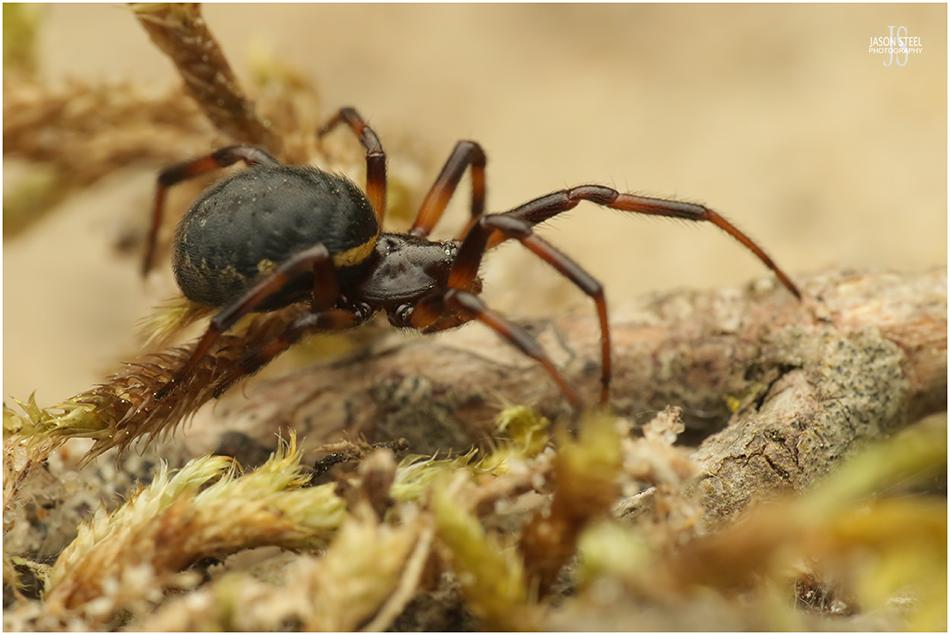
6mm female Steatoda albomaculata, photographed at Holkham, north Norfolk, in June 2024
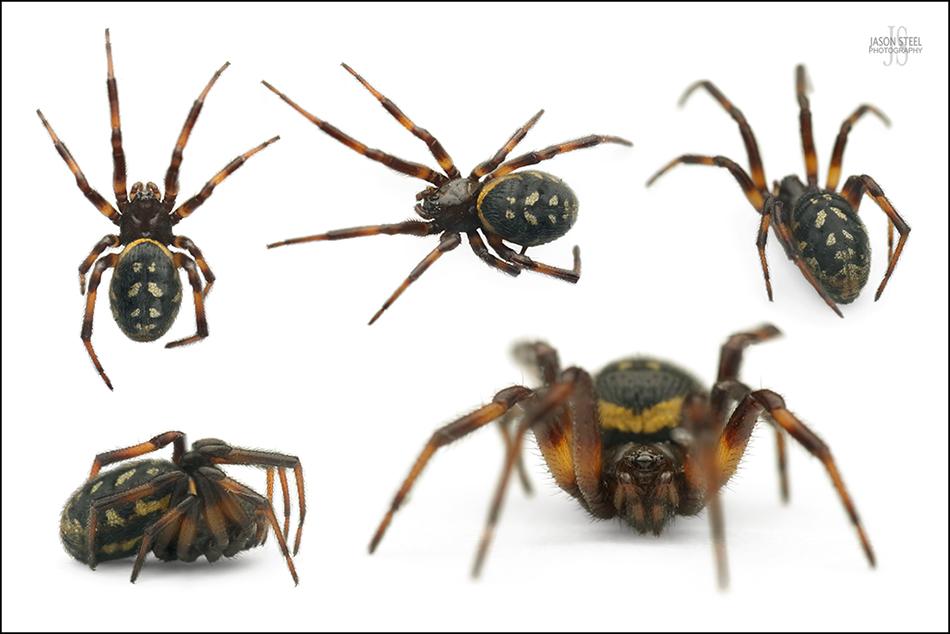
5mm female Steatoda albomaculata, photographed at Holkham, north Norfolk, in June 2024
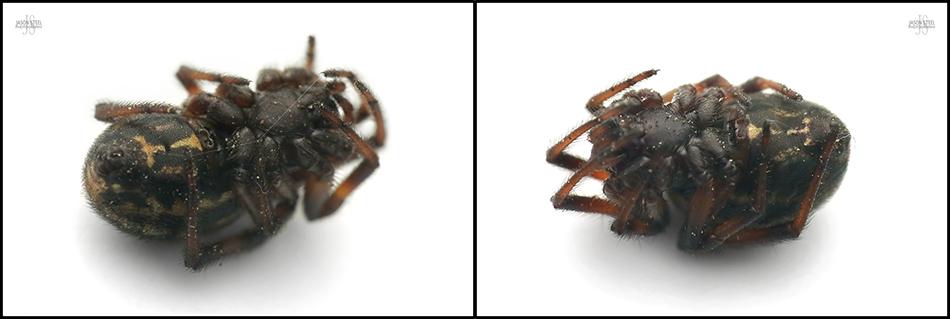
Ventral markings of two female Steatoda albomaculata, photographed at Holkham, north Norfolk, in June 2024
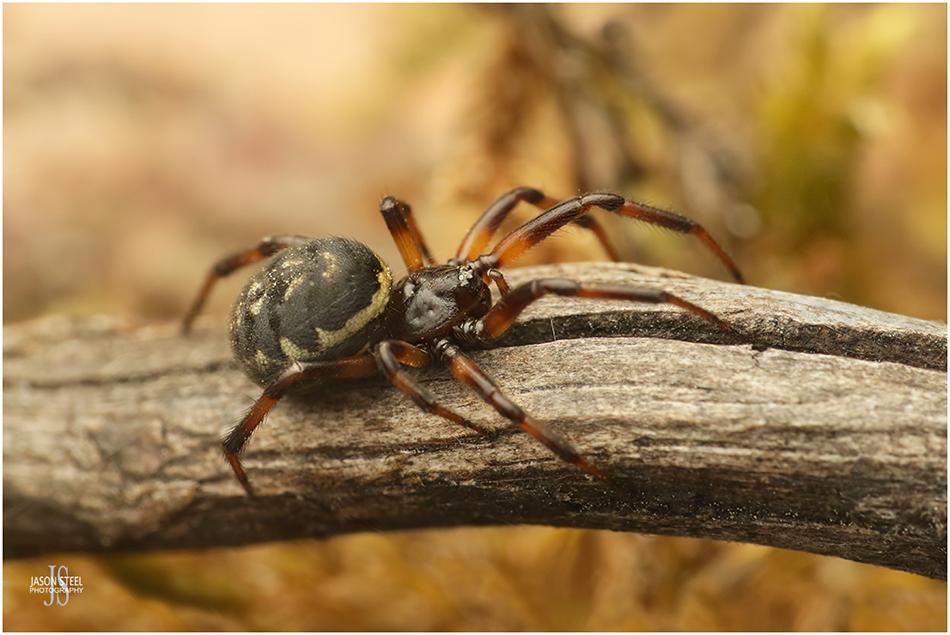
6mm female Steatoda albomaculata, photographed at Holkham, north Norfolk, 30th June 2025
Searching for the White-Spotted False Widow in May & June 2025
At the beginning of May in 2025 I decided to resume my search for the White-Spotted False Widow. I had read via a post on the British Spider ID Group that this species was more easily found on the sand dunes at Burnham Overy, a coastal site that joined onto Holkham Beach. Despite extensive searching for two days at Burnham Overy I was unable to locate a single specimen. I then took my search back to Holkham, where I had previously found two White-Spotted False Widows in 2024, and searched the sand dunes in that area. Once again I had no success in finding this illusive spider.
Later in the year I discovered that I was mistaken and that Steatoda albomaculata hadn't been photographed at Burnham Overy at all, they were actually found at Blakeney Point. - LINK Blakeney Point is another coastal site with a dune system near to Holkham. So at the end of June my wife and I headed back up to Norfolk to look for the White-Spotted False Widow, this time at Blakeney Point. Unfortunately what I didn't know was that Blakeney Point has very restricted access due to coastal flooding, and it's only accessible for a short period of time during each day, depending on the tidal times. By the time we learned of this it was already too late for us to visit the site. I decided that if Blakeney Point was only accessible for a couple of hours, at low tide, then I didn't want to waste what little time we had in Norfolk trying to find the exact spot where the spiders could be found at Blakeney Point. There was the strong possibility that even if I managed to find the spiders there that by the time I had located the spiders at Blakeney Point I would have no time left to photograph them before the tide came in and cut off our return to the mainland.
It was frustrating that we had come all the way up to north Norfolk for the second time this year only to have our plans thwarted. I then came to the conclusion that my best chance of finding this spider was to once again take my search back to the dunes at Holkham, where I had found the White-Spotted False Widow the previous year.
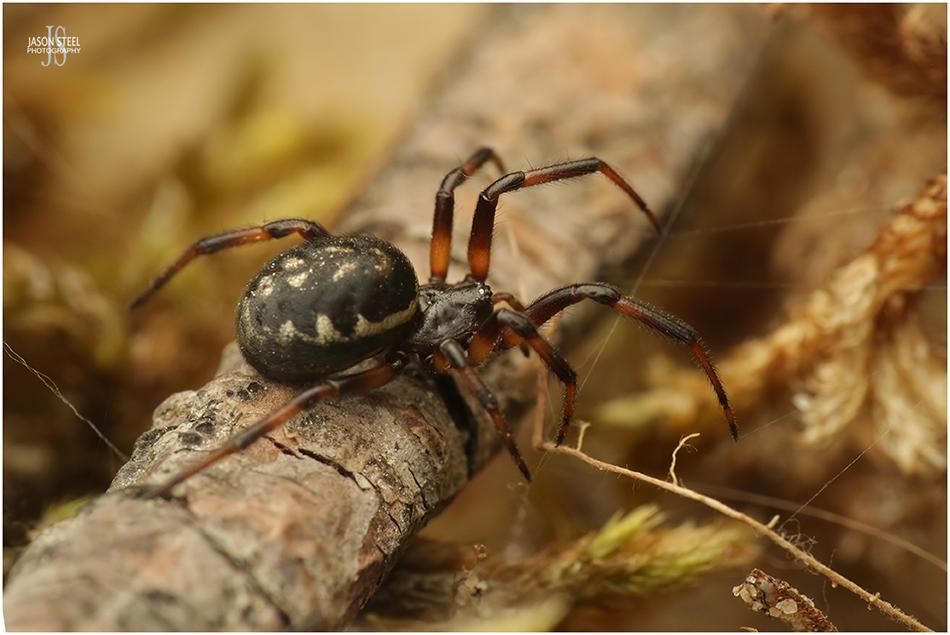
6mm female Steatoda albomaculata, photographed at Holkham, north Norfolk, 30th June 2025
Thankfully over the next two days I was able to find the White-Spotted False Widow on the old grey dunes at Holkham. On this visit I was able to find three adult female specimens. They weren't the boldly marked specimens that I had hoped to photograph but it was still a huge relief to find them. Just as before each specimen was found with its web built under overhanging vegetation on the sandy pathways leading through the old dunes. None of these specimens were found sitting in their web though. With each specimen I found the small, abandoned-looking tangle web first, and then found the spider hidden away out of sight, next to the web.
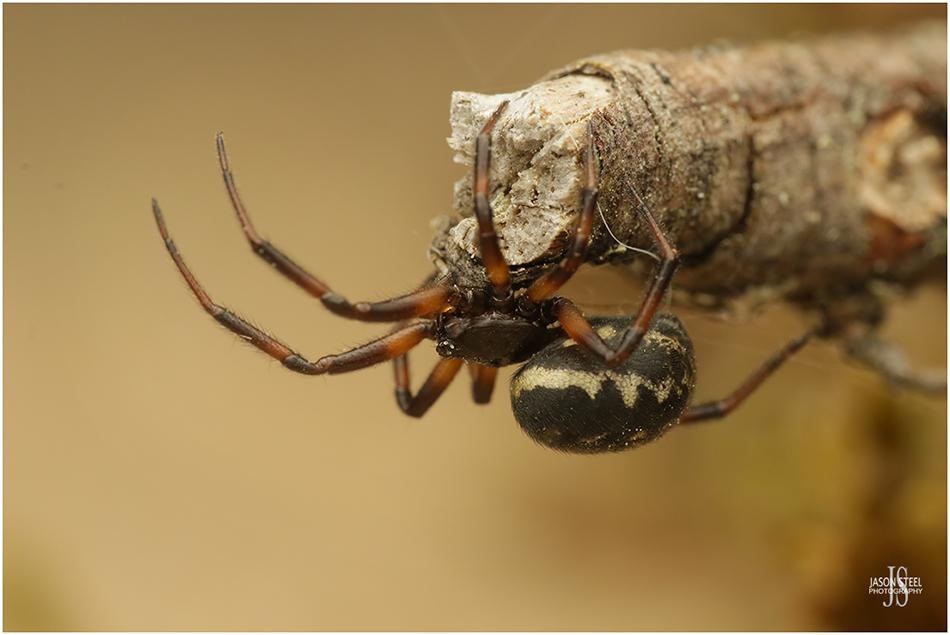
6mm female Steatoda albomaculata, photographed at Holkham, north Norfolk, 30th June 2025
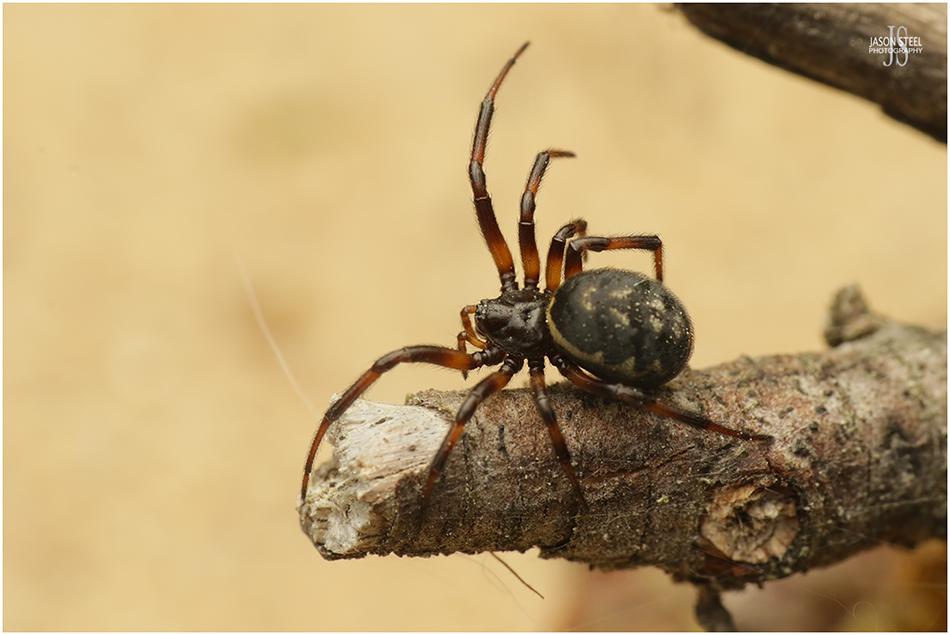
6mm female Steatoda albomaculata, photographed at Holkham, north Norfolk, 30th June 2025
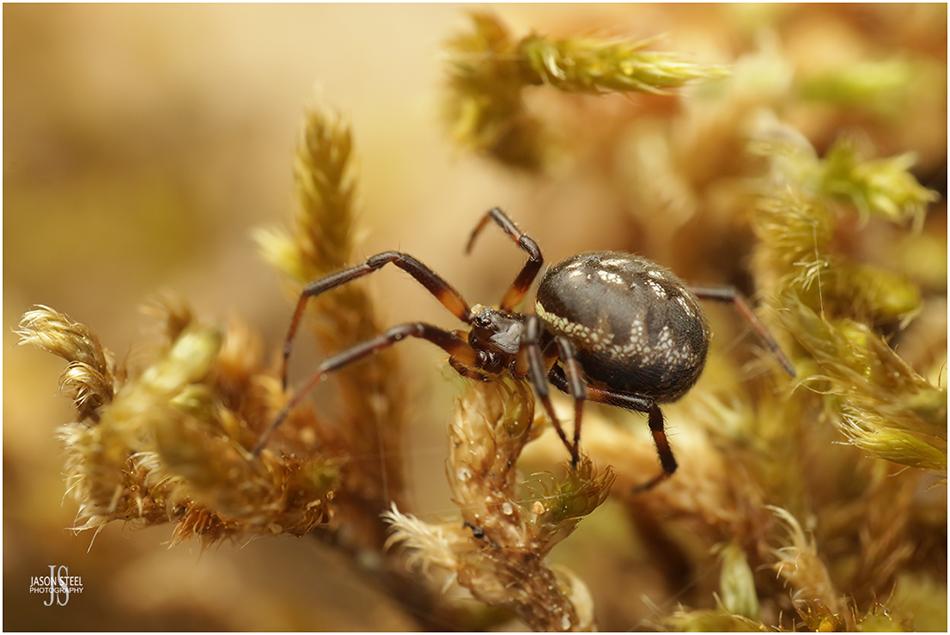
5mm female Steatoda albomaculata, photographed at Holkham, north Norfolk, 29th June 2025

5mm female Steatoda albomaculata, photographed at Holkham, north Norfolk, 29th June 2025
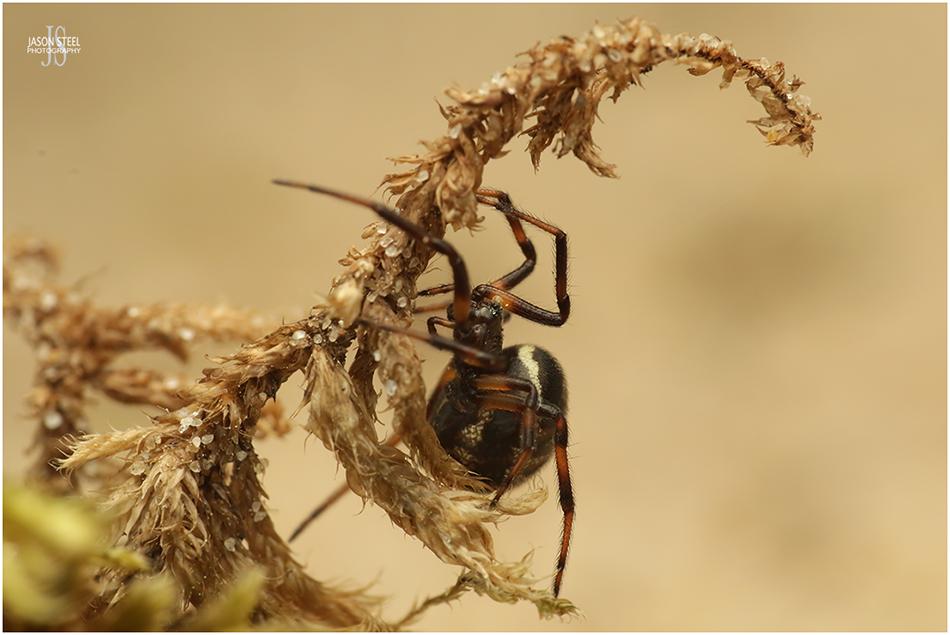
5mm female Steatoda albomaculata, photographed at Holkham, north Norfolk, 29th June 2025
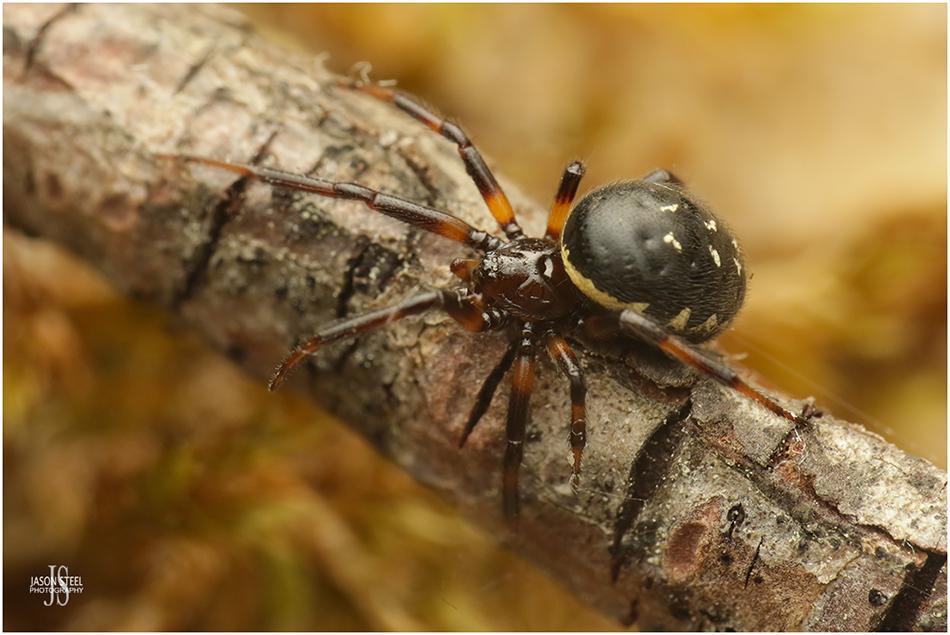
6mm female Steatoda albomaculata, photographed at Holkham, north Norfolk, 29th June 2025
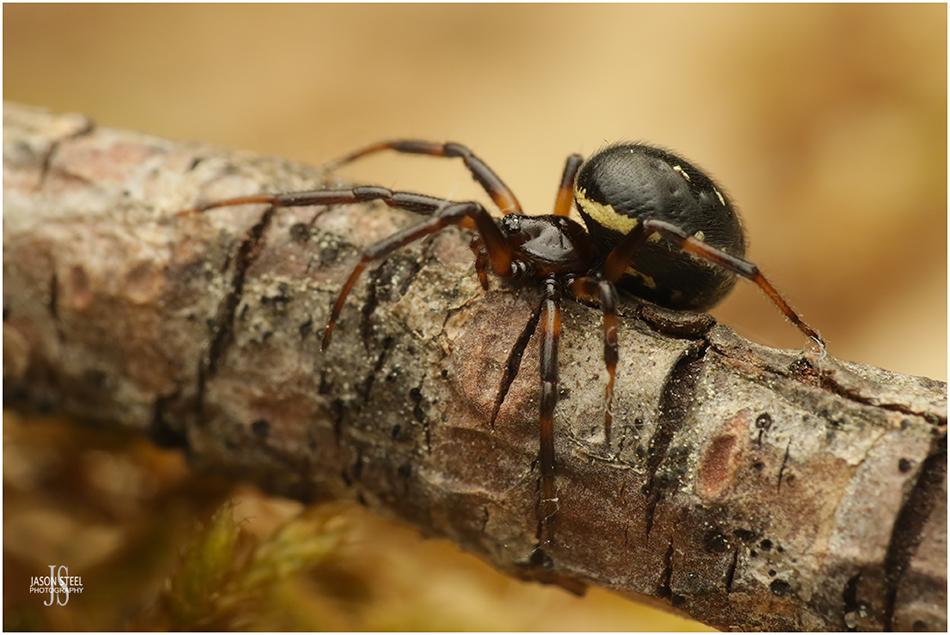
6mm female Steatoda albomaculata, photographed at Holkham, north Norfolk, 29th June 2025
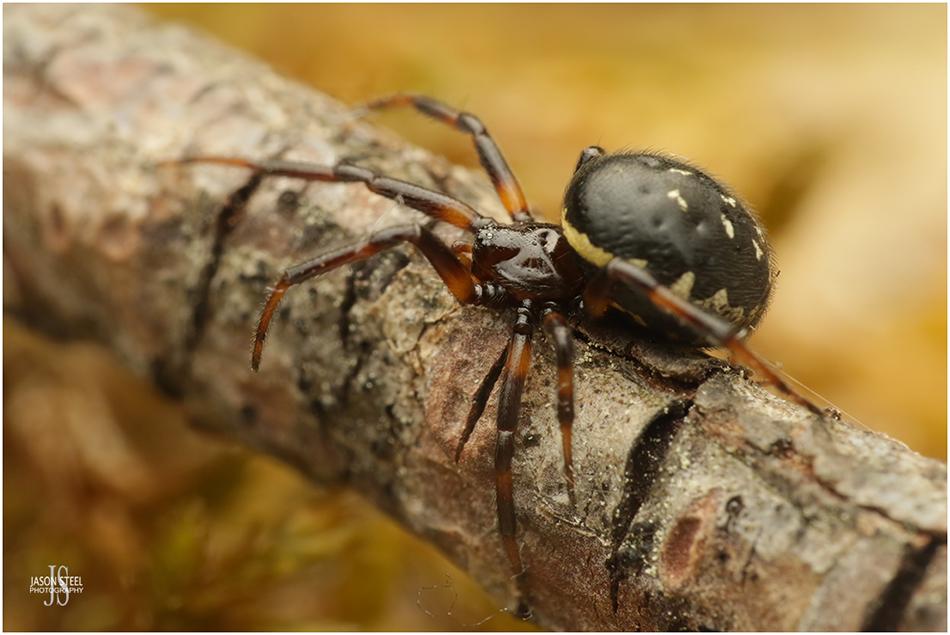
6mm female Steatoda albomaculata, photographed at Holkham, north Norfolk, 29th June 2025
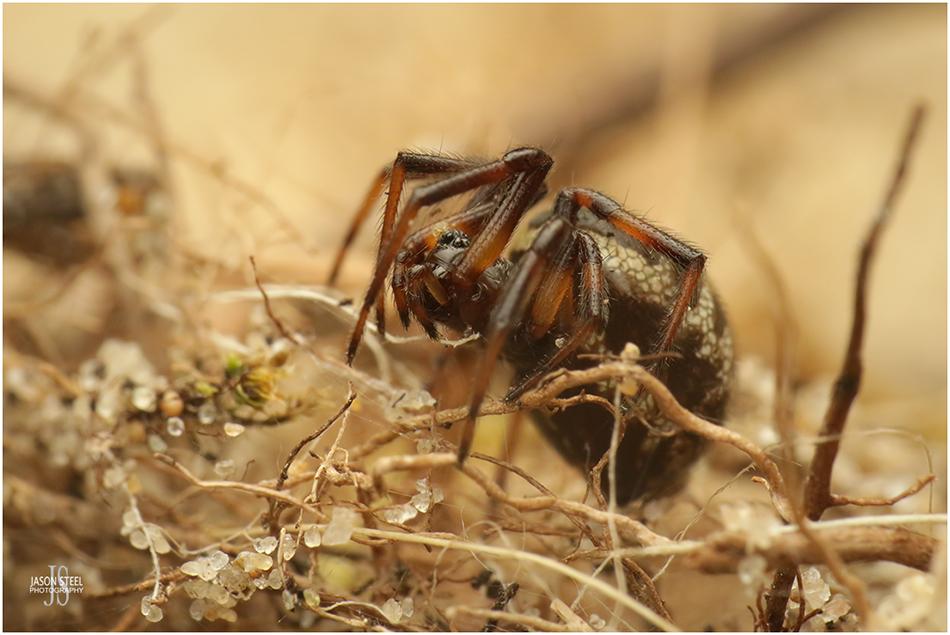
5mm female Steatoda albomaculata, photographed at Holkham, north Norfolk, 29th June 2025
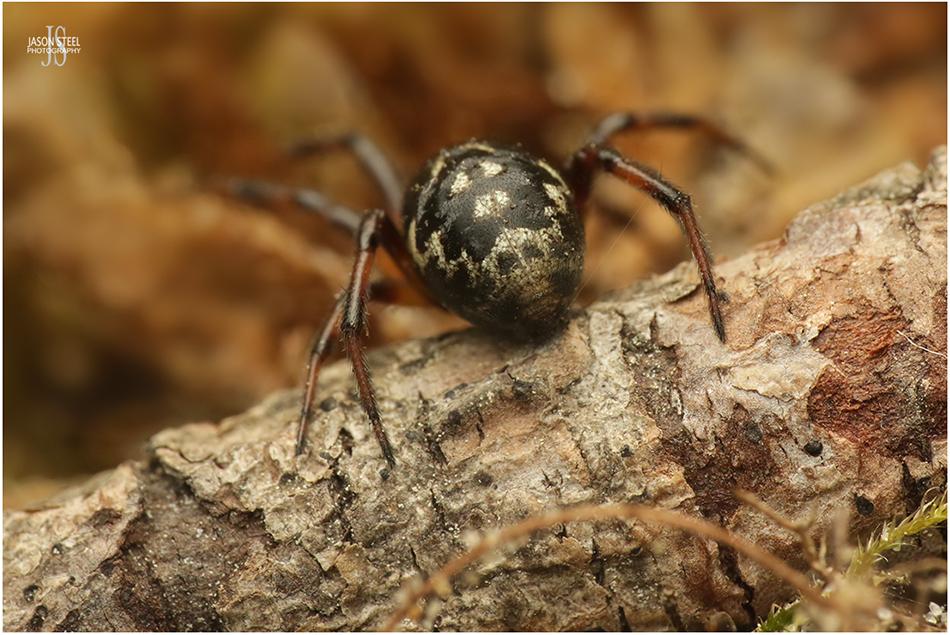
5mm female Steatoda albomaculata, photographed at Holkham, north Norfolk, 29th June 2025
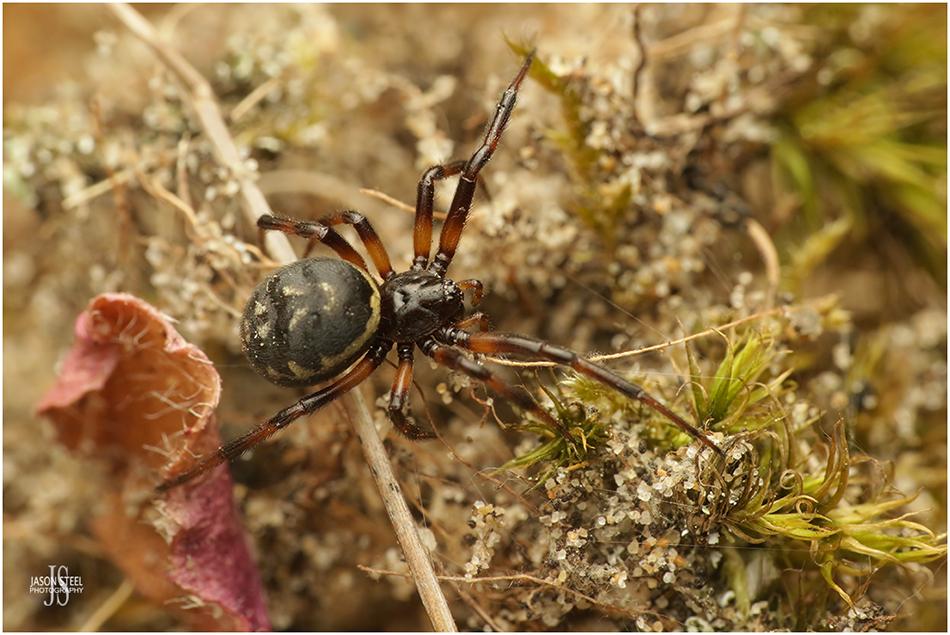
6mm female Steatoda albomaculata, photographed at Holkham, north Norfolk, 30th June 2025
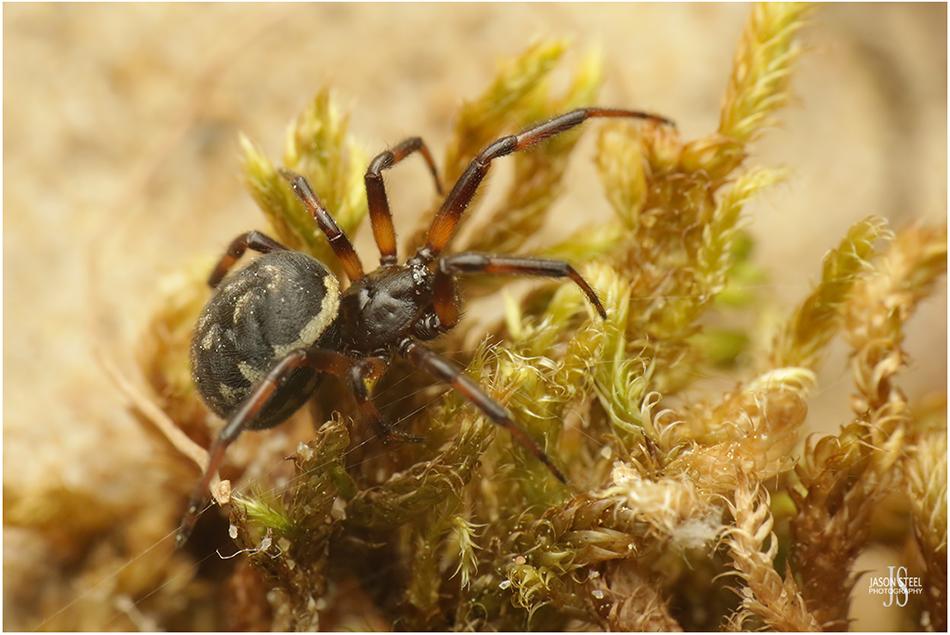
6mm female Steatoda albomaculata, photographed at Holkham, north Norfolk, 30th June 2025
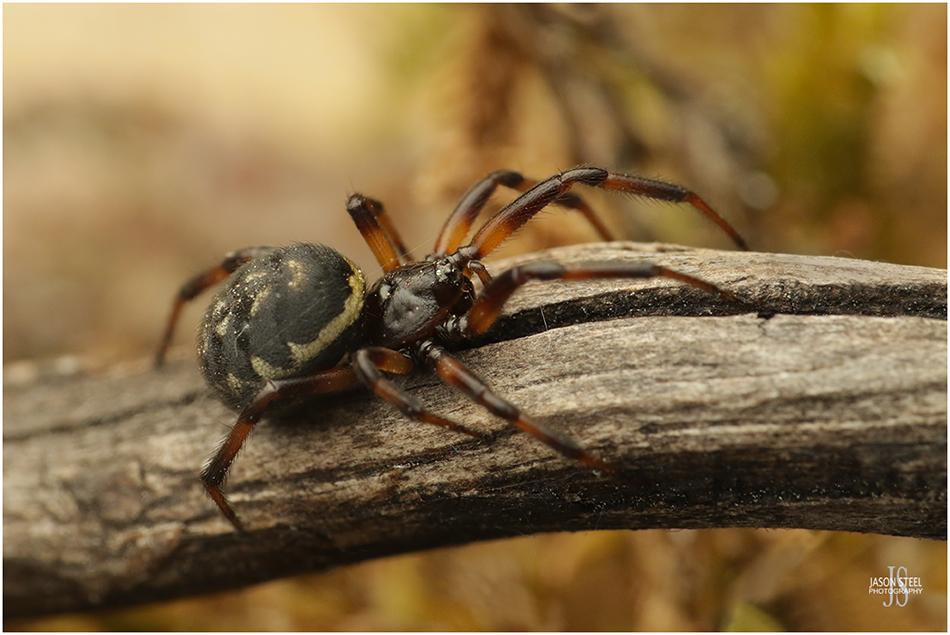
6mm female Steatoda albomaculata, photographed at Holkham, north Norfolk, 30th June 2025
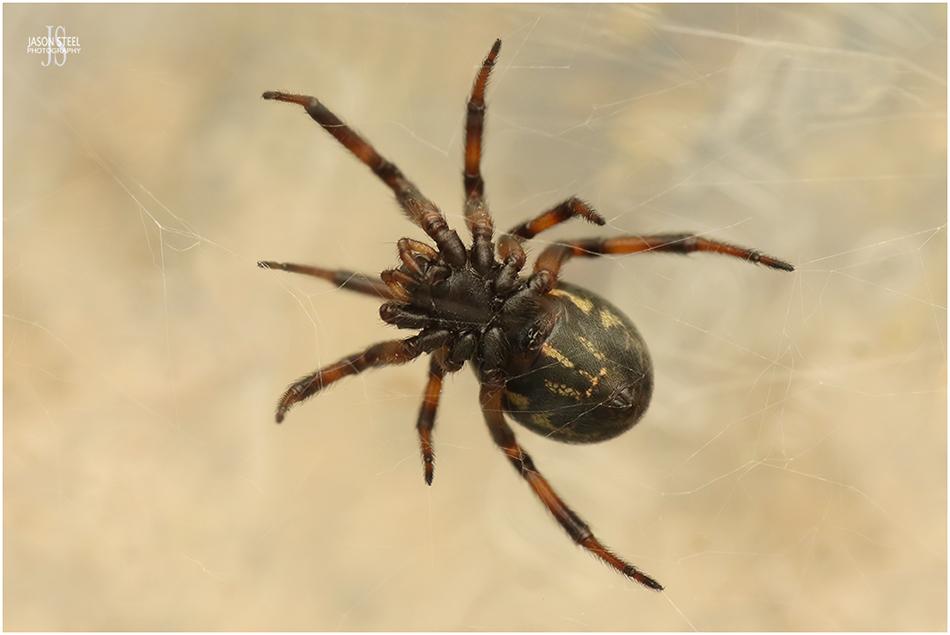
6mm female Steatoda albomaculata, photographed at Holkham, north Norfolk, 30th June 2025
Searching for the White-Spotted False Widow in August 2025
On August 24th I headed back up to the north Norfolk coast for my third visit of 2025. This time I started my search very early in the morning and continued searching until it started getting dark. That's over 12 hours of thorough searching along the sand dunes of both Holkham and Burnham Overy. Yet again my main goal was to find and photograph a boldly marked sub-adult, or recently matured, female White-Spotted False Widow, or even an adult male specimen. So far I've yet to find any juveniles or male specimens. I also wanted to see if I could find this species anywhere else along that coastal dune system other than the two small areas on the Old Grey Dunes where I had previously found them.
Despite my extensive searching I was unable to find Steatoda albomaculata at any other point along the 3 mile stretch of coastal dunes. Thankfully I was able to find two adult female specimens, but both were located in exactly the same small area where my previous specimens had been found in June of this year. This does pose some worrying questions and leads me to have serious concerns about the long-term future of Steatoda albomaculata at this site. So why isn't this species found elsewhere along this beach? Why aren't Steatoda albomaculata established in the dunes at the adjoined Burnham Overy? Is Steatoda albomaculata in decline at Holkham? With so few specimens being present at this site the gene pool must be pretty weak. Surely inbreeding with closely related specimens must be a regular occurrence and will only lead to this rare species dying out in the area?
Of the two adult female Steatoda albomaculata that I was able to find during this visit one had a body-length of 5mm and the other had reached 6mm in length. Both webs were located, as with all previous specimens, under the overhanging edges of the dunes. Both webs were surrounded by webs of both the Labyrinth Spider, Agelena labyrinthica, and that of House Spiders, Tegenaria sp. The Easter Fox Spider, Alopecosa barbipes, was also abundant in the immediate vicinity. Is competeition from other arachnid species proving too much for the White-Spotted False Widow at Holkham?
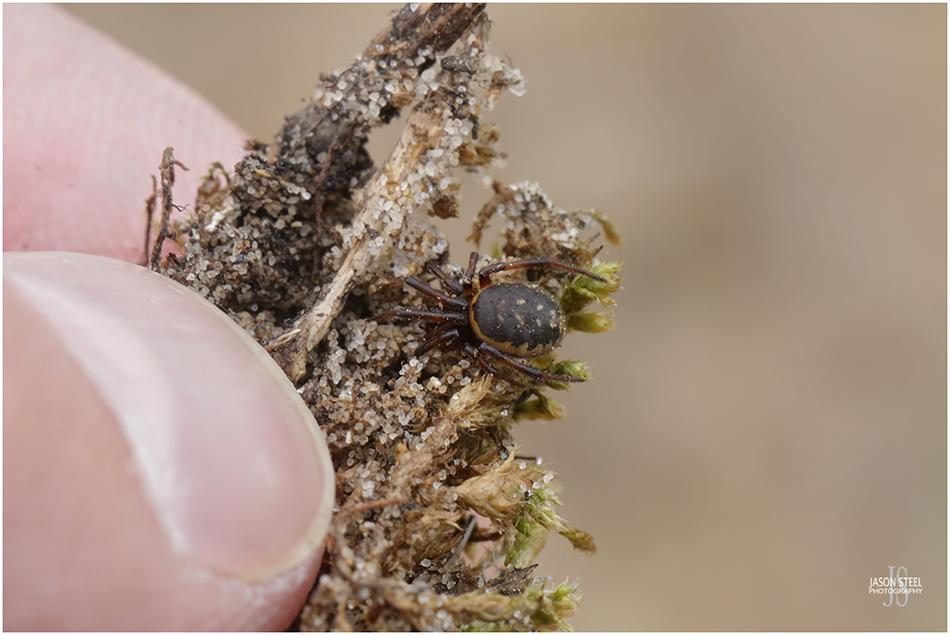
5mm female Steatoda albomaculata, photographed at Holkham, north Norfolk, 24th August 2025
This image of an adult female Steatoda albomaculata shows just how small this False Widow species is.
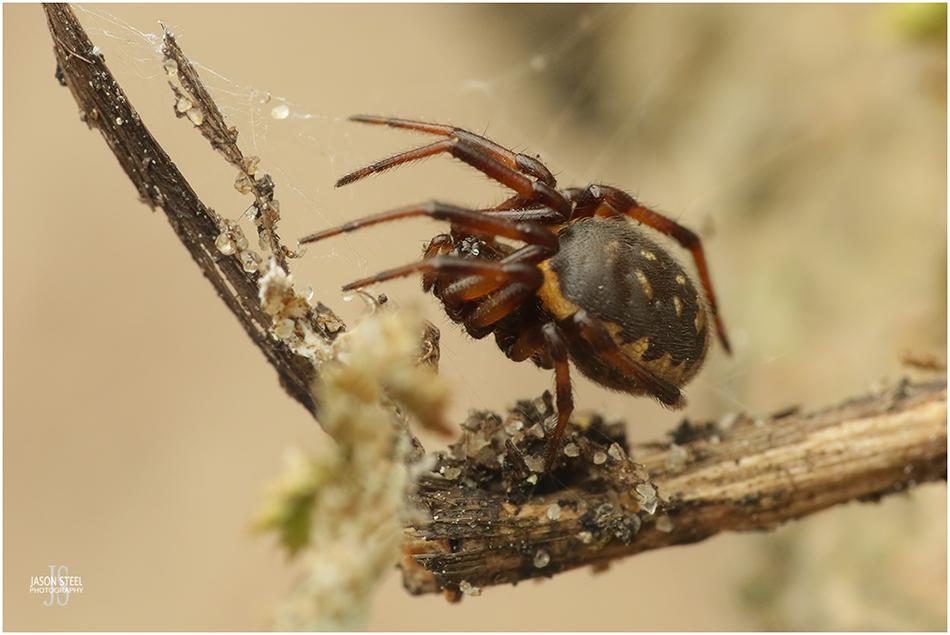
5mm female Steatoda albomaculata, photographed at Holkham, north Norfolk, 24th August 2025
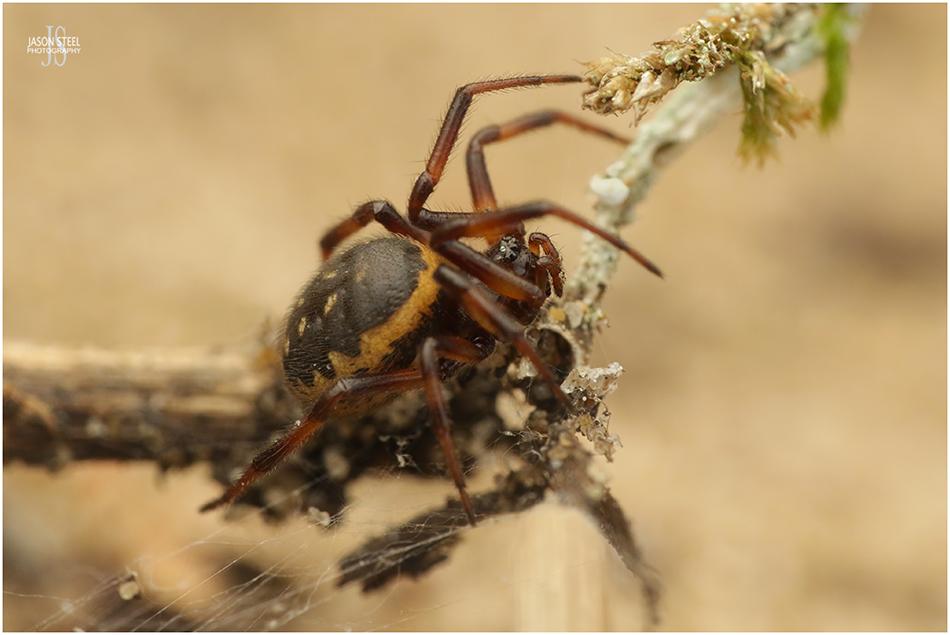
5mm female Steatoda albomaculata, photographed at Holkham, north Norfolk, 24th August 2025

5mm female Steatoda albomaculata, photographed at Holkham, north Norfolk, 24th August 2025

5mm female Steatoda albomaculata, photographed at Holkham, north Norfolk, 24th August 2025

5mm female Steatoda albomaculata, photographed at Holkham, north Norfolk, 24th August 2025
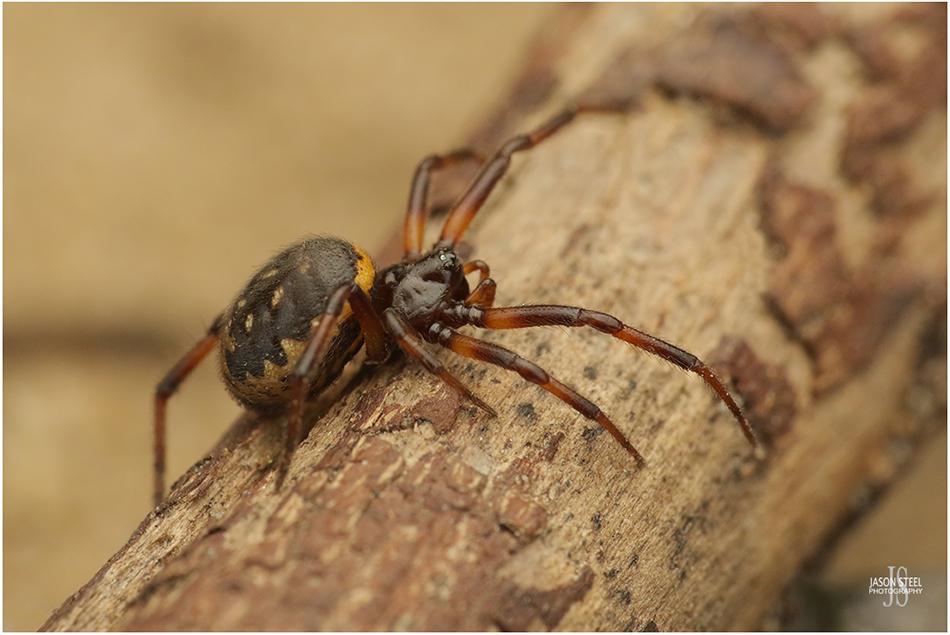
5mm female Steatoda albomaculata, photographed at Holkham, north Norfolk, 24th August 2025
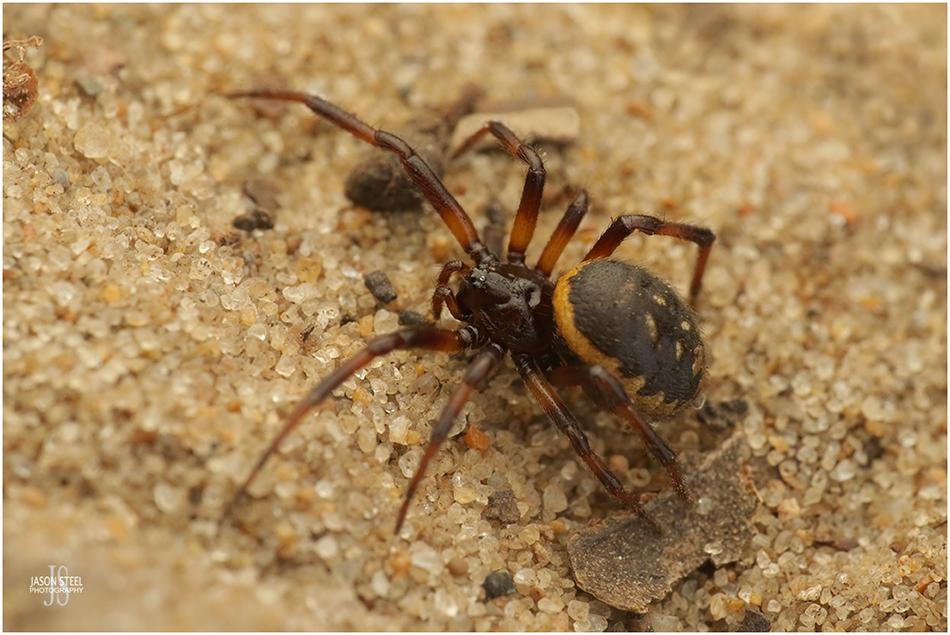
5mm female Steatoda albomaculata, photographed at Holkham, north Norfolk, 24th August 2025

All photographs and text on this page are copyright protected by law, and are the intellectual property of Jason Steel. Do not use without my written consent.
Photographs were taken using:
Canon 7D mkII camera, and the Canon 100mm f/2.8L IS Macro lens, Raynox 250 macro attachment lens, with Canon 580 EX flash and MK Diffuser.